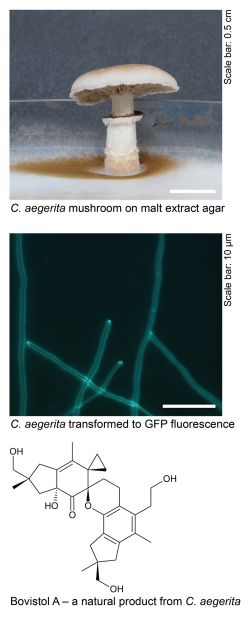
Fungi are almost ubiquitous microorganisms with a great potential for various applications in medicine, biotechnology and food production. Being continuously exposed to various antagonists, fruiting body-forming members of the Basidiomycota – basidiomycetous mushrooms – maintain their ecological fitness mainly by evolving chemical defense mechanisms. To achieve a molecular understanding of fruiting and defense, we apply functional genetics approaches, transcription profiling and collaborative analytical chemistry approaches. Beyond fundamental research, our findings may increase yield and quality in edible mushroom production, and they may extend the spectrum of available bioactive compounds, e.g. for biocontrol via biopesticides.
In this context, we have chiefly focused on the Black Poplar Mushroom Cyclocybe aegerita (syn. Agrocybe aegerita) as a model system, still devoting some attention to its relatives. Cyclocybe aegerita is a cultivated choice edible mushroom exhibiting the rare feature of monokaryotic fruiting sensu stricto (fruiting without mating) and an interesting repertoire of bioactive metabolites.
In collaborative approaches with colleagues from our research field as well as in interdisciplinary collaborations, and by combining a wide range of classical microbiology/mycology methodology, genomics, gene expression analyses and molecular genetics techniques, our group has not only histologically analyzed dikaryotic and monokaryotic fruiting by C. aegerita and, more recently, by its Pacific parasitic cousin Cyclocybe parasitica. Likewise, we have accomplished genome and fructification transcriptome sequencing, and we have enabled functional genetics approaches to C. aegerita. Also, we have started to tap the biotechnological potential of C. aegerita and other mushrooms as a treasure trove for bioactive metabolites with potential applications in medicine and agriculture, e.g. for pest and disease (vector) control. In addition, via multilocus phylogenetic analysis on strains from different continents that is supported by morpho-physiological data, we have delimited European C. aegerita from a new Asian species complex and related species. Most recently, we have engaged in collaboration with colleagues from the fungal ecology field to explore the adaptive potential of mushrooms when they fruit under stressful conditions in the context of climate change and anthropogenic ecosystem alteration.
PD Dr. Florian Hennicke – principal investigator (temporary position, DFG grant HE 7849/3-1, project No. 437330589)
Hannah Elders, B.Sc.